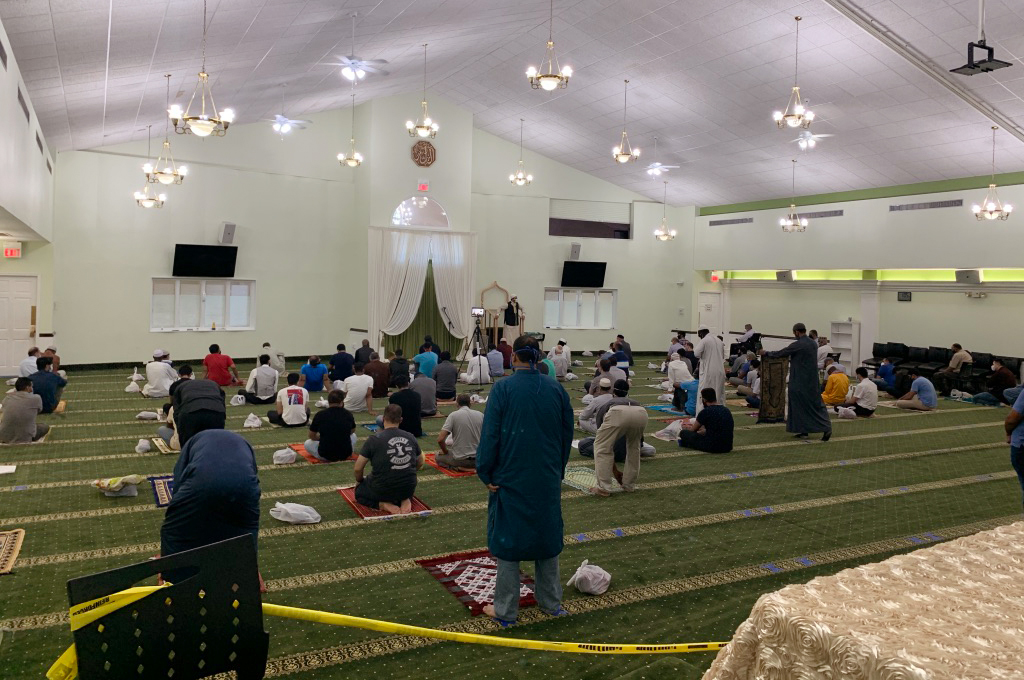Menu
Menu

Islamic Center of Wheaton
August 23, 2020
The last prayer service I attended in the Chicago area was at the Islamic Center of Wheaton (ICW), which is a mosque set in a western Chicago suburb known for being a hub of conservative Christians due to the presence of the evangelical Wheaton College in the heart of the town. The mosque is located in a former church. The exterior and interior benefitted from a recent renovation and looked tidy and clean. The appearance mirrored the organized COVID regulations, and mosque employees set up a prudent system for congregants to enter and exit the mosque through different doors to avoid too many people passing by one another.
The mosque leadership had put together a very streamlined registration and entry process, starting with online registration and QR code to enter the mosque. Upon entering, all congregants had their QR code scanned, their temperature taken, were given a bag to carry their shoes, and were offered hand sanitizer and masks, as well as a paper prayer “carpet.” A different mosque volunteer managed each station as congregants made their way to the prayer hall.
The mosque leadership had put together a very streamlined registration and entry process, starting with online registration and QR code to enter the mosque. Upon entering, all congregants had their QR code scanned, their temperature taken, were given a bag to carry their shoes, and were offered hand sanitizer and masks, as well as a paper prayer “carpet.” A different mosque volunteer managed each station as congregants made their way to the prayer hall.
I was met inside the mosque entrance by the treasurer, who gave me a warm welcome and visitor’s pass so I could move freely throughout the mosque. On Fridays, the women’s prayer area was in a wholly separate and smaller-sized room at the back of the building where a few women gathered for prayers and watched the imam and the congregation on the screen. I did not see any women in the mosque on this day. Because I was given a pass as a researcher, my host let me observe from the back of the main prayer hall, where I had a clear view of the entire congregation.
Men were lined up in rows, with spacing according to tape on the carpet. About 100 filled the main prayer room and then about 50 filled a social hall in the back, with chairs to denote where worshipers should stand during the sermon. Despite being at full capacity, the social distancing sufficiently followed local government requirements.
Men were lined up in rows, with spacing according to tape on the carpet. About 100 filled the main prayer room and then about 50 filled a social hall in the back, with chairs to denote where worshipers should stand during the sermon. Despite being at full capacity, the social distancing sufficiently followed local government requirements.


I recorded the service from the back of the hall, where the sound quality was quite good, and I could also capture the general ambiance of the hall. The imam gave the khutba wearing a mask the entire time, unlike at the other mosques where the imams removed their masks for the sermon. At the end of the sermon, the imam led the congregation in a swift communal prayer, and immediately after, the men quickly filed outside through the side entrance. As people began to leave, the imam announced that a man wanted to take shahada and become a Muslim, so the imam quickly led him through the process of making his shahada, or testimony of faith. The imam mentioned that because of COVID, people should avoid giving the man hugs and kisses, a contrast to the usual practice of showering new converts with hugs and kisses after their testimony of faith.
Soon after, the hall was almost empty, with just a few men lingering in the lobby, some of them not taking precautions for social distancing. The tension between wanting to take precautions and wanting to follow usual practices was evident in the actions of the congregants as they navigated a new and complex way of being in congregation with their fellow Muslims during a global pandemic.
Soon after, the hall was almost empty, with just a few men lingering in the lobby, some of them not taking precautions for social distancing. The tension between wanting to take precautions and wanting to follow usual practices was evident in the actions of the congregants as they navigated a new and complex way of being in congregation with their fellow Muslims during a global pandemic.

